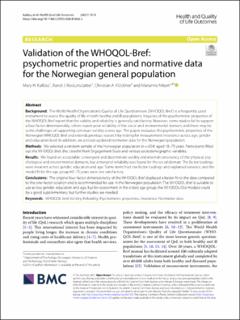| dc.contributor.author | Kalfoss, Mary | |
| dc.contributor.author | Reidunsdatter, Randi Johansen | |
| dc.contributor.author | Kløckner, Christian | |
| dc.contributor.author | Nilsen, Marianne | |
| dc.date.accessioned | 2021-02-09T12:48:12Z | |
| dc.date.available | 2021-02-09T12:48:12Z | |
| dc.date.created | 2021-01-15T15:28:46Z | |
| dc.date.issued | 2021 | |
| dc.identifier.citation | Health and Quality of Life Outcomes. 2021, 19 (1), 1-12 | en_US |
| dc.identifier.issn | 1477-7525 | |
| dc.identifier.uri | https://hdl.handle.net/11250/2726913 | |
| dc.description.abstract | Background: The World Health Organization’s Quality of Life Questionnaire (WHOQOL-Bref ) is a frequently used instrument to assess the quality of life in both healthy and ill populations. Inquiries of the psychometric properties of the WHOQOL-Bref report that the validity and reliability is generally satisfactory. However, some studies fail to support a four-factor dimensionality; others report poor reliability of the social and environmental domain; and there may be some challenges of supporting construct validity across age. This paper evaluates the psychometric properties of the Norwegian WHOQOL-Bref and extends previous research by testing for measurement invariance across age, gender and education level. In addition, we provide updated normative data for the Norwegian population.
Methods: We selected a random sample of the Norwegian population (n=654) aged 18–75 years. Participants flled out the WHOQOL-Bref, the Utrecht Work Engagement Scale and various sociodemographic variables.
Results: We found an acceptable convergent and discriminate validity and internal consistency of the physical, psychological and environmental domains, but a marginal reliability was found for the social domain. The factor loadings were invariant across gender, education and age. Some items had low factor loadings and explained variance, and the model ft for the age group 60–75 years were less satisfactory.
Conclusions: The original four-factor dimensionality of the WHOQOL-Bref displayed a better ft to the data compared to the one-factor solution and is recommended for use in the Norwegian population. The WHOQOL-Bref is suitable to use across gender, education and age, but for assessment in the oldest age group, the WHOQOL-Old module could be a good supplementary, but further studies are needed. | en_US |
| dc.language.iso | eng | en_US |
| dc.publisher | BioMed Central | en_US |
| dc.subject | normative data | en_US |
| dc.subject | invariance | en_US |
| dc.subject | psychometric properties | en_US |
| dc.subject | reliability | en_US |
| dc.subject | validity | en_US |
| dc.subject | WHOQOL-bref | en_US |
| dc.title | Validation of the WHOQOL-Bref: psychometric properties and normative data for the Norwegian general population | en_US |
| dc.type | Peer reviewed | en_US |
| dc.type | Journal article | en_US |
| dc.description.version | publishedVersion | en_US |
| dc.rights.holder | Open Access | en_US |
| dc.source.pagenumber | 1-12 | en_US |
| dc.source.volume | 19 | en_US |
| dc.source.journal | Health and Quality of Life Outcomes | en_US |
| dc.source.issue | 1 | en_US |
| dc.identifier.doi | 10.1186/s12955-020-01656-x | |
| dc.identifier.cristin | 1872270 | |
| dc.source.articlenumber | 13 | en_US |
| cristin.ispublished | true | |
| cristin.fulltext | original | |
| cristin.qualitycode | 1 | |
